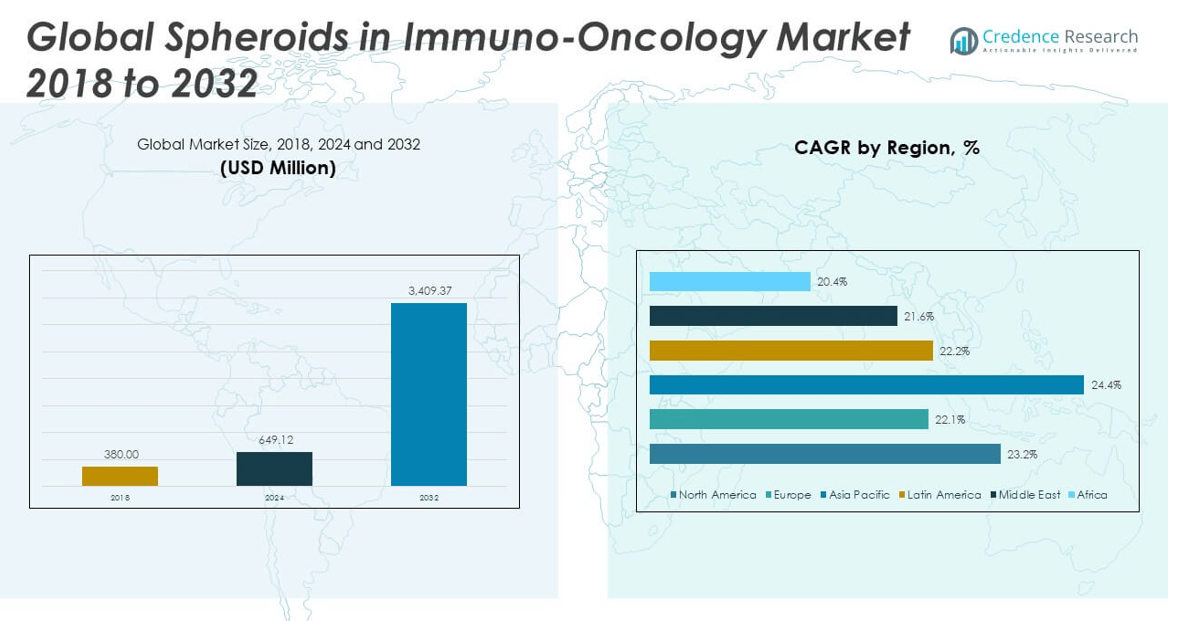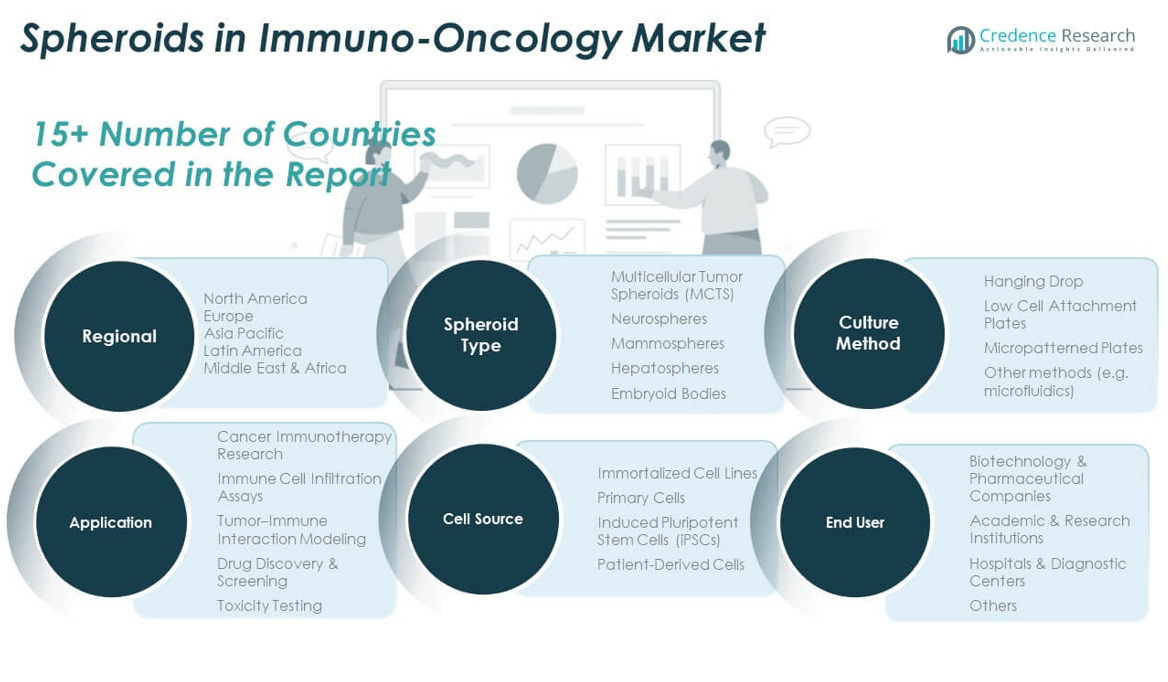CHAPTER NO. 1 : GENESIS OF THE MARKET
1.1 Market Prelude – Introduction & Scope
1.2 The Big Picture – Objectives & Vision
1.3 Strategic Edge – Unique Value Proposition
1.4 Stakeholder Compass – Key Beneficiaries
CHAPTER NO. 2 : EXECUTIVE LENS
2.1 Pulse of the Industry – Market Snapshot
2.2 Growth Arc – Revenue Projections (USD Million)
2.3. Premium Insights – Based on Primary Interviews
CHAPTER NO. 3 : SPHEROIDS IN IMMUNO-ONCOLOGY MARKET FORCES & INDUSTRY PULSE
3.1 Foundations of Change – Market Overview
3.2 Catalysts of Expansion – Key Market Drivers
3.2.1 Momentum Boosters – Growth Triggers
3.2.2 Innovation Fuel – Disruptive Technologies
3.3 Headwinds & Crosswinds – Market Restraints
3.3.1 Regulatory Tides – Compliance Challenges
3.3.2 Economic Frictions – Inflationary Pressures
3.4 Untapped Horizons – Growth Potential & Opportunities
3.5 Strategic Navigation – Industry Frameworks
3.5.1 Market Equilibrium – Porter’s Five Forces
3.5.2 Ecosystem Dynamics – Value Chain Analysis
3.5.3 Macro Forces – PESTEL Breakdown
3.6 Price Trend Analysis
3.6.1 Regional Price Trend
3.6.2 Price Trend by product
CHAPTER NO. 4 : KEY INVESTMENT EPICENTER
4.1 Regional Goldmines – High-Growth Geographies
4.2 Product Frontiers – Lucrative Product Categories
4.3 Application Sweet Spots – Emerging Demand Segments
CHAPTER NO. 5: REVENUE TRAJECTORY & WEALTH MAPPING
5.1 Momentum Metrics – Forecast & Growth Curves
5.2 Regional Revenue Footprint – Market Share Insights
5.3 Segmental Wealth Flow – Spheroid Type & Application Revenue
CHAPTER NO. 6 : TRADE & COMMERCE ANALYSIS
6.1. Import Analysis by Region
6.1.1. Global Spheroids in Immuno-Oncology Market Import Revenue By Region
6.2. Export Analysis by Region
6.2.1. Global Spheroids in Immuno-Oncology Market Export Revenue By Region
CHAPTER NO. 7 : COMPETITION ANALYSIS
7.1. Company Market Share Analysis
7.1.1. Global Spheroids in Immuno-Oncology Market: Company Market Share
7.2. Global Spheroids in Immuno-Oncology Market Company Revenue Market Share
7.3. Strategic Developments
7.3.1. Acquisitions & Mergers
7.3.2. New Product Launch
7.3.3. Regional Expansion
7.4. Competitive Dashboard
7.5. Company Assessment Metrics, 2024
CHAPTER NO. 8 : SPHEROIDS IN IMMUNO-ONCOLOGY MARKET – BY SPHEROID TYPE SEGMENT ANALYSIS
8.1. Spheroids in Immuno-Oncology Market Overview by Spheroid Type Segment
8.1.1. Spheroids in Immuno-Oncology Market Revenue Share By Spheroid Type
8.2. Multicellular Tumor Spheroids (MCTS)
8.3. Neurospheres
8.4. Mammospheres
8.5. Hepatospheres
8.6. Embryoid Bodies
CHAPTER NO. 9 : SPHEROIDS IN IMMUNO-ONCOLOGY MARKET – BY APPLICATION SEGMENT ANALYSIS
9.1. Spheroids in Immuno-Oncology Market Overview by Application Segment
9.1.1. Spheroids in Immuno-Oncology Market Revenue Share By Application
9.2. Cancer Immunotherapy Research
9.3. Immune Cell Infiltration Assays
9.4. Tumor–Immune Interaction Modeling
9.5. Drug Discovery & Screening
9.6. Toxicity Testing
CHAPTER NO. 10 : SPHEROIDS IN IMMUNO-ONCOLOGY MARKET – BY END-USER SEGMENT ANALYSIS
10.1. Spheroids in Immuno-Oncology Market Overview by End-user Segment
10.1.1. Spheroids in Immuno-Oncology Market Revenue Share By End-user
10.2. Biotechnology & Pharmaceutical Companies
10.3. Academic & Research Institutions
10.4. Hospitals & Diagnostic Centers
10.5. Others
CHAPTER NO. 11 : SPHEROIDS IN IMMUNO-ONCOLOGY MARKET – BY CULTURE METHOD SEGMENT ANALYSIS
11.1. Spheroids in Immuno-Oncology Market Overview by Culture Method Segment
11.1.1. Spheroids in Immuno-Oncology Market Revenue Share By Culture Method
11.2. Hanging Drop
11.3. Low Cell Attachment Plates
11.4. Micropatterned Plates
11.5. Other methods (e.g. microfluidics)
CHAPTER NO. 12 : SPHEROIDS IN IMMUNO-ONCOLOGY MARKET – BY CELL SOURCE SEGMENT ANALYSIS
12.1. Spheroids in Immuno-Oncology Market Overview by Cell Source Segment
12.1.1. Spheroids in Immuno-Oncology Market Revenue Share By Cell Source
12.2. Immortalized Cell Lines
12.3. Primary Cells
12.4. Induced Pluripotent Stem Cells (iPSCs)
12.5. Patient-Derived Cells
CHAPTER NO. 13 : SPHEROIDS IN IMMUNO-ONCOLOGY MARKET – REGIONAL ANALYSIS
13.1. Spheroids in Immuno-Oncology Market Overview by Region Segment
13.1.1. Global Spheroids in Immuno-Oncology Market Revenue Share By Region
13.1.2. Regions
13.1.3. Global Spheroids in Immuno-Oncology Market Revenue By Region
13.1.4. Spheroid Type
13.1.5. Global Spheroids in Immuno-Oncology Market Revenue By Spheroid Type
13.1.6. Application
13.1.7. Global Spheroids in Immuno-Oncology Market Revenue By Application
13.1.8. End-user
13.1.9. Global Spheroids in Immuno-Oncology Market Revenue By End-user
13.1.10. Culture Method
13.1.12. Global Spheroids in Immuno-Oncology Market Revenue By Culture Method
13.1.13. Cell Source
13.1.14. Global Spheroids in Immuno-Oncology Market Revenue By Cell Source
CHAPTER NO. 14 : NORTH AMERICA SPHEROIDS IN IMMUNO-ONCOLOGY MARKET – COUNTRY ANALYSIS
14.1. North America Spheroids in Immuno-Oncology Market Overview by Country Segment
14.1.1. North America Spheroids in Immuno-Oncology Market Revenue Share By Region
14.2. North America
14.2.1. North America Spheroids in Immuno-Oncology Market Revenue By Country
14.2.2. Spheroid Type
14.2.3. North America Spheroids in Immuno-Oncology Market Revenue By Spheroid Type
14.2.4. Application
14.2.5. North America Spheroids in Immuno-Oncology Market Revenue By Application
14.2.6. End-user
14.2.7. North America Spheroids in Immuno-Oncology Market Revenue By End-user
14.2.8. Culture Method
14.2.9. North America Spheroids in Immuno-Oncology Market Revenue By Culture Method
14.2.10. Cell Source
14.2.11. North America Spheroids in Immuno-Oncology Market Revenue By Cell Source
14.3. U.S.
14.4. Canada
14.5. Mexico
CHAPTER NO. 15 : EUROPE SPHEROIDS IN IMMUNO-ONCOLOGY MARKET – COUNTRY ANALYSIS
15.1. Europe Spheroids in Immuno-Oncology Market Overview by Country Segment
15.1.1. Europe Spheroids in Immuno-Oncology Market Revenue Share By Region
15.2. Europe
15.2.1. Europe Spheroids in Immuno-Oncology Market Revenue By Country
15.2.2. Spheroid Type
15.2.3. Europe Spheroids in Immuno-Oncology Market Revenue By Spheroid Type
15.2.4. Application
15.2.5. Europe Spheroids in Immuno-Oncology Market Revenue By Application
15.2.6. End-user
15.2.7. Europe Spheroids in Immuno-Oncology Market Revenue By End-user
15.2.8. Culture Method
15.2.9. Europe Spheroids in Immuno-Oncology Market Revenue By Culture Method
15.2.10. Cell Source
15.2.11. Europe Spheroids in Immuno-Oncology Market Revenue By Cell Source
15.3. UK
15.4. France
15.5. Germany
15.6. Italy
15.7. Spain
15.8. Russia
15.9. Rest of Europe
CHAPTER NO. 16 : ASIA PACIFIC SPHEROIDS IN IMMUNO-ONCOLOGY MARKET – COUNTRY ANALYSIS
16.1. Asia Pacific Spheroids in Immuno-Oncology Market Overview by Country Segment
16.1.1. Asia Pacific Spheroids in Immuno-Oncology Market Revenue Share By Region
16.2. Asia Pacific
16.2.1. Asia Pacific Spheroids in Immuno-Oncology Market Revenue By Country
16.2.2. Spheroid Type
16.2.3. Asia Pacific Spheroids in Immuno-Oncology Market Revenue By Spheroid Type
16.2.4. Application
16.2.5. Asia Pacific Spheroids in Immuno-Oncology Market Revenue By Application
16.2.6. End-user
16.2.7. Asia Pacific Spheroids in Immuno-Oncology Market Revenue By End-user
16.2.8. Culture Method
16.2.9. Asia Pacific Spheroids in Immuno-Oncology Market Revenue By Culture Method
16.2.10. Cell Source
16.2.11. Asia Pacific Spheroids in Immuno-Oncology Market Revenue By Cell Source
16.3. China
16.4. Japan
16.5. South Korea
16.6. India
16.7. Australia
16.8. Southeast Asia
16.9. Rest of Asia Pacific
CHAPTER NO. 17 : LATIN AMERICA SPHEROIDS IN IMMUNO-ONCOLOGY MARKET – COUNTRY ANALYSIS
17.1. Latin America Spheroids in Immuno-Oncology Market Overview by Country Segment
17.1.1. Latin America Spheroids in Immuno-Oncology Market Revenue Share By Region
17.2. Latin America
17.2.1. Latin America Spheroids in Immuno-Oncology Market Revenue By Country
17.2.2. Spheroid Type
17.2.3. Latin America Spheroids in Immuno-Oncology Market Revenue By Spheroid Type
17.2.4. Application
17.2.5. Latin America Spheroids in Immuno-Oncology Market Revenue By Application
17.2.6. End-user
17.2.7. Latin America Spheroids in Immuno-Oncology Market Revenue By End-user
17.2.8. Culture Method
17.2.9. Latin America Spheroids in Immuno-Oncology Market Revenue By Culture Method
17.2.10. Cell Source
17.2.11. Latin America Spheroids in Immuno-Oncology Market Revenue By Cell Source
17.3. Brazil
17.4. Argentina
17.5. Rest of Latin America
CHAPTER NO. 18 : MIDDLE EAST SPHEROIDS IN IMMUNO-ONCOLOGY MARKET – COUNTRY ANALYSIS
18.1. Middle East Spheroids in Immuno-Oncology Market Overview by Country Segment
18.1.1. Middle East Spheroids in Immuno-Oncology Market Revenue Share By Region
18.2. Middle East
18.2.1. Middle East Spheroids in Immuno-Oncology Market Revenue By Country
18.2.2. Spheroid Type
18.2.3. Middle East Spheroids in Immuno-Oncology Market Revenue By Spheroid Type
18.2.4. Application
18.2.5. Middle East Spheroids in Immuno-Oncology Market Revenue By Application
18.2.6. End-user
18.2.7. Middle East Spheroids in Immuno-Oncology Market Revenue By End-user
18.2.8. Culture Method
18.2.9. Middle East Spheroids in Immuno-Oncology Market Revenue By Culture Method
18.2.10. Cell Source
18.2.11. Middle East Spheroids in Immuno-Oncology Market Revenue By Cell Source
18.3. GCC Countries
18.4. Israel
18.5. Turkey
18.6. Rest of Middle East
CHAPTER NO. 19 : AFRICA SPHEROIDS IN IMMUNO-ONCOLOGY MARKET – COUNTRY ANALYSIS
19.1. Africa Spheroids in Immuno-Oncology Market Overview by Country Segment
19.1.1. Africa Spheroids in Immuno-Oncology Market Revenue Share By Region
19.2. Africa
19.2.1. Africa Spheroids in Immuno-Oncology Market Revenue By Country
19.2.2. Spheroid Type
19.2.3. Africa Spheroids in Immuno-Oncology Market Revenue By Spheroid Type
19.2.4. Application
19.2.5. Africa Spheroids in Immuno-Oncology Market Revenue By Application
19.2.6. End-user
19.2.7. Africa Spheroids in Immuno-Oncology Market Revenue By End-user
19.2.8. Culture Method
19.2.9. Africa Spheroids in Immuno-Oncology Market Revenue By Culture Method
19.2.10. Cell Source
19.2.11. Africa Spheroids in Immuno-Oncology Market Revenue By Cell Source
19.3. South Africa
19.4. Egypt
19.5. Rest of Africa
CHAPTER NO. 20 : COMPANY PROFILES
20.1. Thermo Fisher Scientific, Inc.
20.1.1. Company Overview
20.1.2. Product Portfolio
20.1.3. Financial Overview
20.1.4. Recent Developments
20.1.5. Growth Strategy
20.1.6. SWOT Analysis
20.2. Merck KGaA (MilliporeSigma)
20.3. Corning Incorporated
20.4. InSphero AG (now part of PerkinElmer)
20.5. STEMCELL Technologies Inc.
20.6. Greiner Bio-One International GmbH
20.7. Hubrecht Organoid Technology (HUB)
20.8. 3D Biotek LLC
20.9. 3D BioMatrix
20.10. Celeste Ltd.
20.11. AMS Biotechnology (Europe) Ltd.









